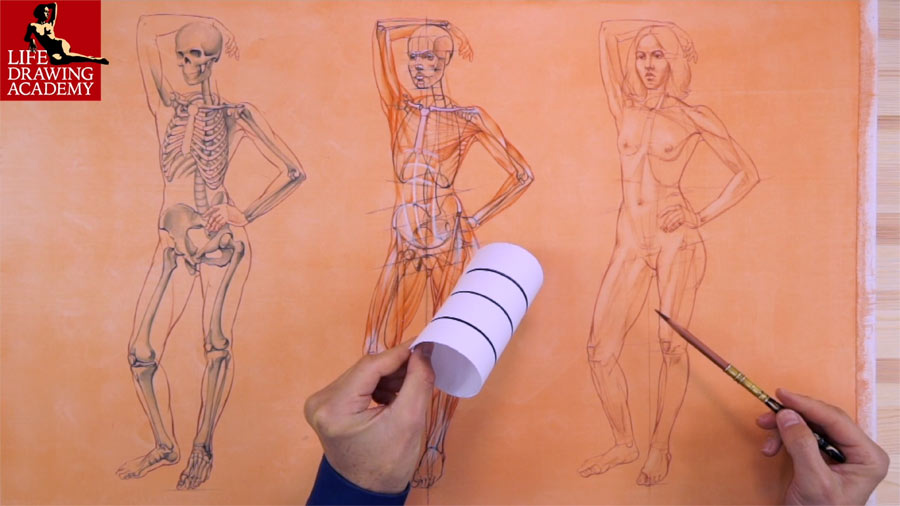Contours vs Outlines - How to use them in Life Drawing
Enroll in the Life Drawing Academy now!
How to Use Outlines and Contours in Life Drawing
To begin with, we need to decide on what are the contours and outlines and why are they important in life drawing? Contours are virtual lines. Do not confuse them with the visible outlines of a body. A contour is a line that can be obtained by intersecting an object with a virtual plane. This line is where the surface of the object intersects with the plane. Because we can use indefinite planes to intersect any object, there will be indefinite contours. Outlines, however, are visible borders around the object. As such, there is a definite number of outlines possible per every object. For example, a sphere has only one outline – the perfect circle that outlines its shape. From every possible point of view, we will only see one outline of a sphere. At the same time, such a sphere can be intersected by virtual planes at different angles. Such planes will produce virtual lines that we would comprehend as ovals or straight lines depending on the view angle. That is why there are only few visible outlines per object and indefinite contours.
In a way, a contour is a straight line that can be drawn on the surface of some three-dimensional object. If this object is not flat, the line will not appear straight when we look on that contour under different angles. That is why such a line describes the object's shape.
Now, why contours are important in life drawing? Contours can be used in life drawing because such virtual lines help to describe the three-dimensional nature of a human body on the flat surface of the drawing.
Marking the direction of contours is not something a professional artist would do, but one would definitely keep in mind. Tonal values rendering looks convincing when pencil strokes go along the contours of a body. This way, an artist describes the three-dimensional nature of an object.
Contours can go at any angle, but some directions describe volumes better than others. In this video, you can see that the model's ribcage is not strictly vertical; it inclines backwards. The pelvis also has its tilt. To understand the contours of the body, you may use a paper cylinder with horizontal lines on it. Such a cylinder can represent various body parts at different angles.
So, when the cylinder is positioned vertically, the marker lines are horizontal and straight. However, the ribcage has the tilt. With this tilt, the horizontal marks no longer appear straight, but curve downward because we see those contours of the cylinder from above. The pelvis, however, has a different tilt. This time, we see the contours of a cylinder from below and the marker lines curve upward.

The same is in a human body. From this point of view, contours of the ribcage are seen from above, so we draw them curving downward. At the same time, the contours of the pelvis are seen from below, so their curvature bows upward.
Contours can describe not only big forms, but volumes of muscles as well. The contours of the model's upper arm, when the elbow points to the viewer in the back-side view, will be seen from below.
Another reason to use contours in life drawing is to render tonal values by applying tonal values along them. This way, with every stroke, you will describe spatial arrangements of the body's volumes and its construction.
Drawing contours is optional. If you are a beginner, I would strongly advise that you do so. Conversely, if you already spent hundreds of hours drawing from life, you could simply keep direction of contours in your mind. Such contours can be used to better describe the form by applying pencil strokes of tonal rendering along that form.
Also, keep in mind that contours are not only perpendicular cross-sections; they can be drafted in any direction. Nevertheless, not every direction would describe the three-dimensional nature of an object the best way. You will find much more information about outlines and contours and how to use them in the Life Drawing Academy course.
To learn good drawing techniques, enroll in the Life Drawing Academy course:
Online Course
A self-study, self-paced course for you to learn fundamental methods of classical drawing and improve life drawing skills by watching video lessons and doing assignments
- Unlimited access to 52 life drawing video lessons
- Lifetime membership without deadlines
- Unlimited support from the Academy tutors
- Constructive critique of your artworks
- Member access to the Academy's Art community
- Place in the Academy's Students Gallery
- Exclusive members-only newsletter and bonuses
- Life Drawing Academy Diploma of Excellence in your name
One-time payment - Lifetime membership
$297 USD
Personal Tutoring Online + Online Course
The ultimate choice if you who would like to receive personal, one-to-one tutoring from the Academy teachers, which is custom-tailored to your skills and needs
- Everything in Online Course, plus:
- Dedicated team of art tutors
- Assessment of your current level of drawing skills
- Personalized curriculum tailored to your skills and goals
- Up to 100 drawing tasks with by-task assessment
- Unlimited one-to-one personal coaching with detailed per-task instructions and feedback
- Artwork critiques and results-oriented guidance
One-time payment - Lifetime membership
$997 USD




